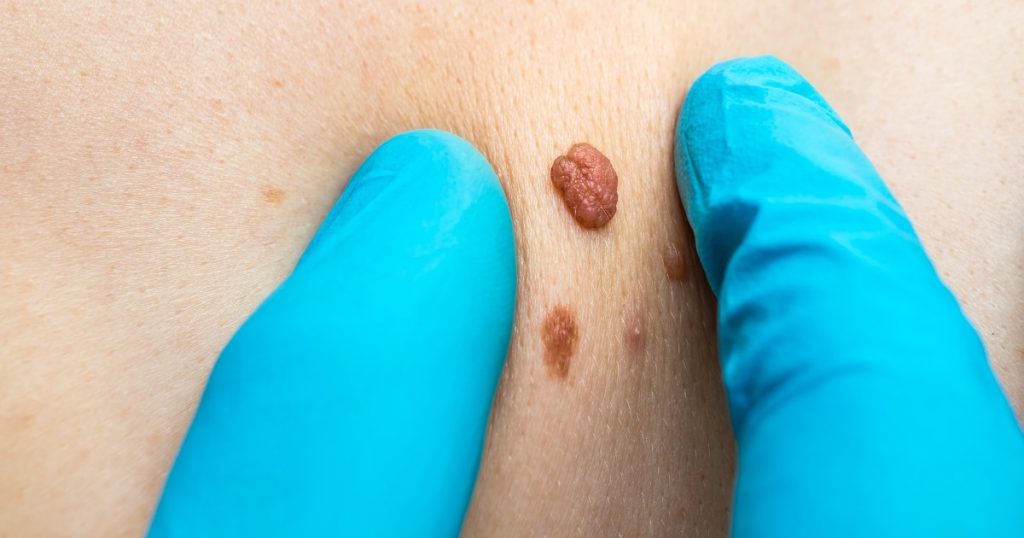Regarding skin health, a common query is, “How do skin tags get removed?” This article aims to simplify the skin tag removal process, explaining the different methods and their effectiveness. We will delve into clinical and home-based techniques, ensuring you have all the necessary information to make an informed decision.
Understanding How Do Skin Tags Get Removed?
Various methods commonly address skin tags, each requiring the expertise of the right specialist for skin tag removal. These methods include tying off the stalk to cut off blood supply, freezing them off with liquid nitrogen, or snipping them off with surgical scissors or a scalpel. It’s crucial to consult with a qualified healthcare professional who can safely and effectively perform these procedures.
Key Points:
- Skin tags can be removed by a doctor or at home with over-the-counter products.
- Freezing skin tags with liquid nitrogen is a common medical procedure that kills the tissue.
- Tying off the skin tag stalk disrupts blood flow, causing the tag to die and fall off.
- A doctor can quickly snip off skin tags using sterilised scissors or a scalpel.
- Apple cider vinegar and tea tree oil are sometimes used as at-home removal remedies.
- After removal, proper wound care helps prevent infection as the area heals
- Skin tags may return even after removal, especially in sites of skin friction
What Causes Skin Tags and How to Remove Them?

Skin tags arise from clusters of collagen and blood vessels getting trapped inside thicker skin folds and are more common in overweight or diabetic patients.
- Obesity, friction, and diabetes are risk factors for developing skin tags
- Genetics may also play a role, as skin tags run in some families
- Skin tags can appear in the armpits, neck, groyne, or under breasts
- While benign, skin tags may become irritated by friction from clothing
- At-home freezing kits utilise liquid nitrogen to remove skin tags
- Tea tree oil and apple cider vinegar are natural at-home remedies
- After skin tag removal, proper wound care is important
Do Skin Tags Fall Off on Their Own or Need Medical Removal?
Skin tags do not typically fall off on their own and usually require removal by surgical scissors, freezing, or tying off the stalk if they become irritated or unsightly.
- Skin tags tend to persist once formed and don’t fall off naturally
- Leaving them alone causes no medical issues if they don’t get irritated
- Clothing friction can cause pain and bleeding of irritated tags
- At-home remedies like tea tree oil may remove very small tags
- Larger skin tags likely need removal by a doctor’s office visit
- Freezing with liquid nitrogen is a common medical removal method
- After removal, the wound site will form a scab and heal over time
What’s the Best At-Home Method for Removing Skin Tags?
The best at-home methods for removing skin tags are tea tree oil and apple cider vinegar applied topically to slowly dry out and kill the skin tag tissue.
Book A Consultation With Dr Shehzadi Tasneem
Top-rated Plastic Surgeon For Skin Tag Removal in Dubai
Installment Plan Available
- Tea tree oil and apple cider vinegar can dry out and kill skin tags
- These treatments take weeks and require multiple applications daily
- Bandaging skin tags during treatment helps concentration
- Freezing spray or freeze-away kits use liquid nitrogen
- Improperly cutting off tags risks infection, bleeding, and scarring
- See a doctor if at-home treatments are too slow or ineffective
- Monitor at-home removal for signs of irritation or infection
How Much Does It Cost to Get Skin Tags Removed by a Doctor?

When considering the cost of getting skin tags removed by a doctor, it’s important to note that prices can vary significantly. The Dubai skin tag removal costs range from AED 600 to AED 20,000. This variation depends on several factors, including the number of skin tags to be removed, the specific freezing method employed, and the extent of insurance coverage.
- Freezing with liquid nitrogen is a fast in-office procedure
- Costs rise if removing many skin tags at once
- Location impacts price – the hospital is more expensive
- Insurance may cover some procedures if tags are irritated
- Pay out of pocket if removal is considered cosmetic
- Shop around, as prices can vary between providers
| Method | Cost Range (AED) |
| Excision | [AED 600 – AED 1,200] |
| Cryotherapy | [AED 800 – AED 1,500] |
| Laser Ablation | [AED 1,000 – AED 2,000] |
The table shows the cost of skin tag removal in Dubai by different methods. The cost ranges from AED 600 to AED 2,000 per skin tag. Excision is the least expensive method, followed by cryotherapy and laser ablation.
Is Freezing With Liquid Nitrogen the Most Effective Way to Remove Skin Tags?

Freezing skin tags using liquid nitrogen is considered one of the most effective medical procedures, with a success rate of over 90%, but it can temporarily damage surrounding skin.
- Liquid nitrogen freezes and kills the skin tag tissue
- The frozen skin tag falls off within 1-2 weeks
- Redness and irritation result as the surrounding skin thaws
- Rarely, some tags may not be fully removed with one freeze
- Freezing is fast, with no stitches or anaesthesia required
- Visit a dermatologist for access to liquid nitrogen
How Long Does It Take for Skin Tags to Heal After Being Removed?
Full healing of a skin tag site after removal usually takes 1-4 weeks, depending on the method used, the location of the body, and how well the wound is cared for.
| Method | Healing Time Frame | Factors Delaying Healing |
| Liquid nitrogen freezing | 7-10 days | Tag location, diabetes, obesity |
| Surgical excision | 2-4 weeks | Depth of excision, infection |
| Tying off stalk | 1-3 weeks | Diabetes, wound care |
| At-home acids | 1-2 weeks | Overaggressive acid use |
| Electrosurgery | 10-14 days | Location on body |
| Laser | 7-14 days | Diabetic patients |
The full skin tag healing duration typically ranges from 1-4 weeks, depending on the removal technique. Body area, health conditions, and proper aftercare impact timeframes. Signs of complications require prompt medical attention.
Can Apple Cider Vinegar or Tea Tree Oil Safely Remove Skin Tags at Home?
Apple cider vinegar and tea tree oil can safely remove some small skin tags when applied topically over weeks, but these home remedies may severely irritate the skin in sensitive areas.
- Natural oils work by slowly drying out skin tags over time
- Take weeks of dedication to applying remedies daily
- Works best on thin, small tags in fleshy areas
- Stings intensely for first days of application
- Irritates sensitive neck and facial areas
- Improper use risks chemical burns, scarring, infection
- See a doctor if home remedies are ineffective after 1 month
What Should I Do If My Skin Tag Isn’t Fully Removed and Starts Bleeding?
If a skin tag doesn’t entirely remove after treatment and starts bleeding, immediately apply pressure with a clean cloth for 10-15 minutes and see a doctor to avoid infection risks.
- Bleeding means the wound has reopened and risks infection
- Apply firm pressure continuously for 10-15 minutes
- Clean the area gently with soap and water when done
- Bandage site to keep clean till seen by a doctor
- Seek medical care promptly to avoid complications
- Further procedures may be required to remove the rest of the tag
- Monitor for abnormal pain, swelling, pus, warmth or redness
Understanding “how skin tags are removed” equips you with the knowledge to choose the right removal method. Whether opting for clinical procedures or at-home remedies, it’s crucial to prioritise safety and effectiveness. Always consult a dermatologist for personalised advice and treatment options.
Dr Shehzadi Tasneem Sultan is a distinguished plastic surgeon renowned for her advanced body contouring and facial rejuvenation skills. With her medical degrees from Allama Iqbal Medical College, Lahore, and a prestigious Fellowship in Plastic Surgery, Dr Sultan has honed her expertise across the globe, including the UK and Dubai. Her commitment to delivering tailored care and achieving natural results is evident in every procedure, from Botox to complex microsurgery.
Step into a world where your beauty aspirations become a reality. Book a consultation with Dr Shehzadi Tasneem Sultan to explore a range of aesthetic solutions perfectly aligned with your individual needs and under the care of a globally recognised plastic surgery expert.
Explore the expertise of the renowned Dr. Shehzadi Tasneem, acclaimed as the best female plastic surgeon in Dubai for transformative and personalized cosmetic enhancements.












